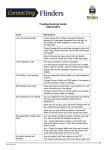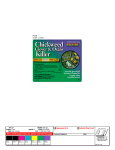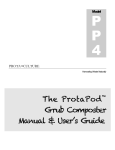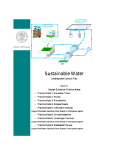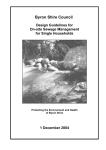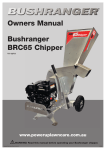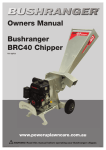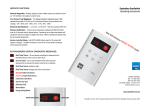Download Owners Manual 2013
Transcript
A&A Worm Farm Waste Systems Pty Ltd Owner’s Manual Owner’s Operating Instructions Biological Waste Solutions with worm technology ALL MODELS A & A WORM FARM WASTE SYSTEMS January 2013 Serial No: Purchased from: A&A WORM FARM WASTE SYSTEMS Date: Details of installation: Name: Address: Phone No: Email: This system shall be installed with permission of the local authority in accordance with the state regulator’s approval conditions. Installation and selling agent: A&A Worm Farm Waste Systems Pty Ltd Unit 5/2135 Frankston -Flinders Road, HASTINGS 3915 Telephone: 61 3 5979 1887 Fax: 61 3 597 9 1854 Web:wormfarm.com.au Email: [email protected] A&A Systems 2 CONTENTS Page A. Description of Worm Farm process 4 B. Organic Waste for your system / Items not for your system 5 C. Customer Responsibility 7 D. Warranty 8 E. Transpiration Area 9 F. Pump system 9 G. Alarm system 9 H. Servicing Requirements 10 I. Trouble shooting 11 J. Electrical & Alarm system 12 System Description Maximum flow ( Litres/day ) PT 3000 LG (Poly tank gravity feed) 1800 PT 3000 LP (Poly tank pump system) 1800 CT 3000 LG (Concrete tank gravity feed) 1800 CT 3000 LP (Concrete tank pump system) 1800 CT 3200 LG (Concrete tank gravity feed) 3200 CT 3200 LP (Concrete tank pump system) 3200 CT 3600 LG (Concrete tank gravity feed) 3600 CT 3600 LP (Concrete tank pump system) 3600 CT 5000 LP (Concrete tank pump system) 4500 CT 5000 LG (Concrete tank gravity feed) 4500 A&A Worm Farm Waste Systems Pty Ltd Unit 5/2135 Frankston -Flinders Road, HASTINGS 3915 Telephone: 61 3 5979 1887 Fax: 61 3 597 9 1854 Web:wormfarm.com.au Email: [email protected] 3 A. DESCRIPTION OF THE WORM FARM PROCESS The system works by using naturally occurring organisms found in a rain forest floor. These include worms, slaters, slugs, snails etc. These process the waste solids into material that is easily taken up in the soil. Worms have the ability to convert a wide range of organic material including sewer waste presented in a varied form. Therefore, for the efficient operation of your Waste System it is desirable to include carbonaceous materials such as vegetable food scraps as well as other organic materials. The objective of adding diverse organic waste is to deodorise and aerate the waste and adjust the systems Carbon/Nitrogen balance, the pH and salinity. Your system is able to recycle all household organic wastes. During processing the waste liquid from the kitchen, shower and toilet (if a flushing toilet is used) enters the chamber where the solids are separated from the liquids, which drain through the organic pile, and is polished. This process is similar to that which happens on the floor of a rain forest. The liquids then continue out of the chamber to an approved closed disposal system. No liquid is stored in the chamber. The design of your Waste System has created a suspended bed of organic material, which allows for a continuous flow of material. Waste is fed to the surface. The worms, which are placed into the system upon commissioning, (this is referred to seeding the system) slaters and naturally occurring organisms, which find their way into the system, live on and multiply with the food source available and stabilise the material. The material is harvested from the base and flushed to the trenches alongside the Waste System. Worms eat 50% to 100% of the own body weight per day. The grinding and tumbling action within the worm gut reduces and sludge particle size exposing a greater surface area to a range of enzymes and a host of bacteria. After excretion the particles continue to be exposed to an aerobic environment in the suspended bed with very high bacterial and fungal populations. These particles are ready to be taken up in the trenches. 4 B. RECOMMENDED ORGANIC GARBAGE QUANTITIES Your system is an engineered environmental friendly Worm Farm Waste System. The worm chamber is design to process up to one (1) kilogram of organic garbage/ person per day. ORGANIC WASTE SUITABLE FOR DISPOSAL IN YOUR SYSTEM All biodegradable and organic waste may be disposed of in the Worm Farm Waste System to be processed by the worms and converted into worm castings. A common sense approach to organic garbage disposal is the best method when deciding what is appropriate and inappropriate for the Worm Farm Waste System. If it grows or may be digested by humans or was manufactured from organic matter it is suitable for disposal in the system. Kitchen food waste Household organic waste Meat Dairy Citrus Weeds – shake excess dirt off before disposing into the system Dead Flowers Dust from the vacuum cleaner Do not dispose of newspapers or cardboard into the system as bundles will not allow airflow. We recommend either recycling or use under mulch in the garden. Eliminate seed contamination on your site from weeds such as docks, thistles, ragwort, agapanthus flower heads and all other noxious weeds by placing them into the Worm Farm Waste System. Prunings from the garden – do not include large branches, they will take a long time to break down. We recommend mulching these which may be reused back onto the garden. Envelopes require plastic from window faced envelopes to be removed. Do not include bundles of glossy magazines as air flow will be restricted between the layers. 5 ITEMS NOT SUITABLE FOR DISPOSAL IN THE WORM FARM WASTE SYSTEM The Worm Farm Waste System cannot process inorganic materials. × Building materials such as plaster board, timber off-cuts, nails, screenings, concrete, tiles, carpet, steel or stainless steel, soil, sand etc Cans – including aluminum or metal Plastic – including drink bottles, plastic wrap, plastic bags, window face on envelopes, CD’s, DVD’s, containers, plastic twine, plastic tape etc Glass – including bottles, dishes, drinking glasses, mirrors, trays, serving platters etc Steel, needles and razor blades etc. Stainless steel Large bones Tetra packs Milk cartons with plastic lining× Fruit & soft drink containers with plastic lining Aluminum foil containers Newspapers, magazines & any quantities of cardboard Disposable nappies, tampons, panty shield and like material Paint & non organic chemicals Bleach Motor oil & grease Kitty litter or like material. Be aware there are some nappies labelled biodegradable, plastic bags etc available within the market place. Our experience has shown they are not suitable for the Worm Farm Waste Systems as they do not break down quickly enough under the system conditions. You will experience a build up of these items which will require removal. If you are unclear on any item you are considering disposing into the Worm Farm Waste System, a phone call to the National Head Office is recommended. We are always pleased to offer advice. Phone number – 03 5979 1887 A&A Worm Farm Waste Systems Pty Ltd Unit 5/2135 Frankston -Flinders Road, HASTINGS 3915 Telephone: 61 3 5979 1887 Fax: 61 3 597 9 1854 Web:wormfarm.com.au Email: [email protected] 6 C. CUSTOMER RESPONSIBILITY On a regular basis, a monthly check should be made on the following; 1. Wind turbine is spinning freely. 2. Vermiculture activity should be checked by observing pile size variations from previous inspections. 3. Ensure there is no soil subsidence around the tank. If subsidence occurs, replace soils to create a shallow mound over the tank. Soil must not exceed 100-150mm depth. 4. If the system is a gravity feed one, check that liquid is flowing from the base to the distribution pit. 5. If the system has remained dormant for more than two years, the system will need to be reseeded with worms. 6. Six monthly checks recommended for any sediment build-up inside the distribution pit. 7. Stock should be fenced away from the trench line. All electrical plugs connected to the Worm Farm Waste System must remain plugged into a power source at all times. It is important to note, plugs have been installed connecting to the power points by our installer in a specific sequence, they must at all times remain in the same sequence. NOTE: If any of the above occurs or you are unsure about any part of the maintenance procedure, please contact your selling agent or A & A Worm Farm Waste Systems. RING 03 5979 1887. 7 D. WARRANTY We have used a septic tank chamber which has been approved and third party certified to Australian Standards AS1546.1 – On-site domestic-wastewater treatment units, Part 1. The structure of the tank has not been altered in the manufacturing process only the addition of a horizontal separator and an Air System. These components are covered by a 10 year Warranty. It is vital that the soil over this chamber is domed to encourage all surface water to run away from it. Soil must not exceed 100-150mm depth. Where the option of a pump is required, the Orange pump has a one-year limited warranty. The alarm and switch has a twelve-month warranty. The trenches we install have a life expectancy of at least 10 years. Trenches are covered by permit conditions issued by Council. These conditions should be read and adhered to. In addition, no building materials, sand, gravel, soil etc. is to be stored over any part of the transpiration area. Evapo/transpiration is an important element in the fundamental function of this area. Vehicles not to be driven over the transpiration area. Stock is not to use this area for grazing. Statement of Service Life: This warranty of the system covers all components apart from pumps and electrical controls to provide a functioning and reliable system for 10 years. A & A Worm Farm Waste Systems cannot be responsible for the transpiration area covering any unknown springs or high water table sites where this is not evident when the installation is conducted or notified by the owners of such hazards. This clause also covers natural events such as land slip, rock falls etc. Groundwater should be kept away from the outside of the tank. An absorption trench drain on gravity systems or a pump is provided for this purpose on flat sites. Power to this external pump should be connected immediately after installation to keep warranty in place. A&A Worm Farm Waste Systems Pty Ltd Unit 5/2135 Frankston -Flinders Road, HASTINGS 3915 Telephone: 61 3 5979 1887 Fax: 61 3 597 9 1854 Web:wormfarm.com.au Email: [email protected] 8 E. TRANSPIRATION AREA All stock should be fenced off from this area. Storm water or any other run off should be redirected away from this area. A cut off drain should be installed when necessary ensuring no run off enters. No foreign material including building material, sand, gravel etc should be stored over this area. Edible plants should be planted at least 2 metres away from this area. As per council requirements and the requirements of this company, ground water and storm water runoff must be diverted away from the trenches. Failing to do this may cause damage to the system. F. PUMP SYSTEM The Orange pump which is activated by a mast head switch and both are located in the pump chute. If the pump does not work an alarm will sound and strobe flashes only if the chamber floods. The external pump can be tested by removing the black pump plug from the white switch plug and placing the black pump plug directly into a known working power source. If the pump works the mast head switch should be checked. Groundwater should be kept away from the outside of the tank. An absorption trench drain on gravity systems or a pump is provided for this purpose on flat sites. Power to this external pump should be connected immediately after installation to keep warranty in place. If the pump does not work disconnect black pump plug and call 03 5979 1887 All electrical plugs connected to the Worm Farm Waste System must remain plugged into a power source at all times. It is important to note, plugs have been installed connecting to the power points by our installer in a specific sequence, they must at all times remain in the same sequence. Note: Energy usage varies depending on daily volume of effluent and pumping head. Generally, energy requirements for effluent pumping is as little as 5 kWh /person/ year. 9 G. ALARM SYSTEM An alarm system is fitted to indicate that the pump is not working or the chamber is flooding. Depending on the systems use there is 3 to 4 days of liquid capacity in the system when the alarm sounds. A power “on light” is provided. You can deactivate the alarm by pressing the mute button. The sound will automatically cease after 5 minutes. The alarm should be connected to mains power with the plug supplied. If the alarm sounds, ring 03 5979 1887 for information. H. SERVICING REQUIREMENTS As required by state regulators, both gravity and pumped systems are to be serviced every 2 years by an accredited service agent to maintain the high level of performance demanded. To maintain warranty it is important to use accredited service agents. This system requires no maintenance by owner as its treatment process is automatically governed by the worm population. SERVICE MAINTENANCE ITEMS Code Preventative service item Labour time A Air supply performance (Whirly vent) 6 minutes D Distribution efficiency (Tank & pit ) 6 minutes E Effluent monitoring check ( Casings etc.) 15 minutes P Pumps & alarm check (internal & external) 15 minutes R Worm activity check S Sludge, worm casing and dispersal area check(s) 8 minutes 10 minutes Note: Labour times are approximate and apply only when performed in conjunction with the bi-annual service. See SERVICE MANUAL for further details of servicing frequency. 10 I. TROUBLE SHOOTING PROBLEM Colour in pump well effluent PROBLEM Pump not operating PROBLEM Floating solids PROBLEM Heavy scum layer in distribution pit OPERATION Odour INDICATION Black indicates no oxygen DO ACTION Check pipe leakage or sludge levels Grey indicating insufficient DO Increase ventilation/recycling rate Yellow indicating clay flushing Remove any sand build-up Clear odorless effluent Good – continue operation CAUSE Overload ACTION Push reset button Power off Switch power on and plugged in. Timer Reset timer Faulty pump Repair or replace pump CAUSE Blocked /damaged filter ACTION Clean lift pump & strainer Sludge build-up Clean WF tanks and pump pits Excessive oil & grease in waste Check grease use/ GIT operation Wasting of WF casings /solids ACTION Check WF & arrange pumping Excessive build-up about 50mm Report for next service PROBLEM Wind ventilation not functioning ACTION Call for whirly vent service High disinfectant residual Decrease household disinfect usage 11 J. ELECTRICAL AND ALARM SYSTEM PROBLEMS OPERATION Switch Board PROBLEM No power to switch board ACTION Notify owner and call electrician No power supply to air pumps See details under circuit breakers No power supply to pump well Check power supply, reset Active alarm system Check high water and air supply Stuck float switch Check float switch and control OPERATION PROBLEM ACTION Fault rectification Circuit breaker tripped Turn circuit breaker on investigate possible reason False alarm Check float levels and wiring Float switch incorrectly set Refer to specifications Alarms not active Check for moisture and wiring PROBLEM Breaker /switch off ACTION Check Incorrect wiring Check Power surge Check Short circuit in electricals Check If fault cannot be rectified Notify owner and call electrician PROBLEM Power outage ACTION System automatically resets Outage storage Pump well has storage for one hour Dual alternation Pumps will alternate automatically Air pumps require manual alternation Rotate air pumps quarterly. Alarms not working Check circuit breakers, power supply and for faulty control box. OPERATION Circuit breakers OPERATION Power supply and 12












